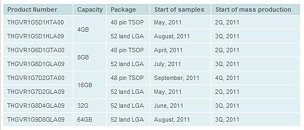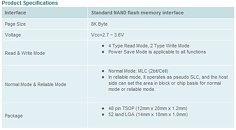- Joined
- Oct 9, 2007
- Messages
- 47,527 (7.48/day)
- Location
- Hyderabad, India
| System Name | RBMK-1000 |
|---|---|
| Processor | AMD Ryzen 7 5700G |
| Motherboard | ASUS ROG Strix B450-E Gaming |
| Cooling | DeepCool Gammax L240 V2 |
| Memory | 2x 8GB G.Skill Sniper X |
| Video Card(s) | Palit GeForce RTX 2080 SUPER GameRock |
| Storage | Western Digital Black NVMe 512GB |
| Display(s) | BenQ 1440p 60 Hz 27-inch |
| Case | Corsair Carbide 100R |
| Audio Device(s) | ASUS SupremeFX S1220A |
| Power Supply | Cooler Master MWE Gold 650W |
| Mouse | ASUS ROG Strix Impact |
| Keyboard | Gamdias Hermes E2 |
| Software | Windows 11 Pro |
Toshiba America Electronic Components, Inc. (TAEC) today announced that it has enhanced its NAND flash portfolio with the introduction of SmartNAND, its next-generation 24-nanometer (nm) NAND flash product family. The SmartNAND series integrates leading-edge 24nm process NAND flash technology with a control chip that supports error correction code (ECC) and is available in densities ranging from 4 to 64 gigabyte (GB).
The new series is expressly designed to remove the burden of ECC from the host processor, while minimizing protocol changes. SmartNAND simplifies the host-side design and application of advanced NAND technology in a range of applications including portable media players, tablet PCs, digital TVs, set-top-boxes, and other devices that require high-density, non-volatile memory.

Market demand continues to grow for high density chips that support high resolution video and enhanced storage, and Toshiba is an established innovator in this key area. The introduction of SmartNAND reinforces its leadership position.
"Toshiba's new SmartNAND will provide our customers a smoother design experience into 24nm generation and beyond," noted Scott Nelson, vice president, Memory Business Unit, Toshiba America Electronic Components, Inc. "By enabling the system designer to directly manage the NAND using a standard or custom host NAND controller, while leaving the function of error correction within the NAND package, SmartNAND results in faster time to market, access to leading geometries and potentially lowers design costs when compared to conventional NAND flash implementations with external ECC."
The new SmartNAND 24nm product lineup is a replacement for current 32nm generation devices. Its advanced process combined with a faster controller and internal interface achieves faster read and write speeds and enhances overall performance. Optimized to suit design objectives, SmartNAND supports a range of read and write speeds including four read modes and two write modes.
Utilizing the long established raw NAND interface, the SmartNAND family includes new features that are optimized for high-capacity and high-performance applications. Managing bit errors is essential so that digital products can maintain acceptable levels of performance and reliability. The integration of error management with the NAND device, in a single package, allows Toshiba's customers to take advantage of high capacity, advanced flash memory solutions that offer excellent error management.
Samples of the new SmartNAND family are available in mid-April and mass production will begin in the second quarter of CY2011 (April to June).
Key Features


View at TechPowerUp Main Site
The new series is expressly designed to remove the burden of ECC from the host processor, while minimizing protocol changes. SmartNAND simplifies the host-side design and application of advanced NAND technology in a range of applications including portable media players, tablet PCs, digital TVs, set-top-boxes, and other devices that require high-density, non-volatile memory.

Market demand continues to grow for high density chips that support high resolution video and enhanced storage, and Toshiba is an established innovator in this key area. The introduction of SmartNAND reinforces its leadership position.
"Toshiba's new SmartNAND will provide our customers a smoother design experience into 24nm generation and beyond," noted Scott Nelson, vice president, Memory Business Unit, Toshiba America Electronic Components, Inc. "By enabling the system designer to directly manage the NAND using a standard or custom host NAND controller, while leaving the function of error correction within the NAND package, SmartNAND results in faster time to market, access to leading geometries and potentially lowers design costs when compared to conventional NAND flash implementations with external ECC."
The new SmartNAND 24nm product lineup is a replacement for current 32nm generation devices. Its advanced process combined with a faster controller and internal interface achieves faster read and write speeds and enhances overall performance. Optimized to suit design objectives, SmartNAND supports a range of read and write speeds including four read modes and two write modes.
Utilizing the long established raw NAND interface, the SmartNAND family includes new features that are optimized for high-capacity and high-performance applications. Managing bit errors is essential so that digital products can maintain acceptable levels of performance and reliability. The integration of error management with the NAND device, in a single package, allows Toshiba's customers to take advantage of high capacity, advanced flash memory solutions that offer excellent error management.
Samples of the new SmartNAND family are available in mid-April and mass production will begin in the second quarter of CY2011 (April to June).
Key Features
- The integrated error correction (ECC) and leading edge 24nm process generation allows for enhanced speed performance of 1.9 times faster read speed and 1.5 times faster write speed than the current lineup.
- Toshiba's SmartNAND offers a range of read and write speeds to vary optimized speed performance; the read speed will be available in four options, and the write speed in two. Power save mode is also available for lower power requests.
- Toshiba's SmartNAND utilizes a standard raw NAND interface, allowing easy replacement of standard NAND. SmartNAND can be applied to existing host controllers with driver software support, if necessary. This simplifies system development, allowing manufacturers to minimize development costs and to improve time to market for new and upgraded products.


View at TechPowerUp Main Site
